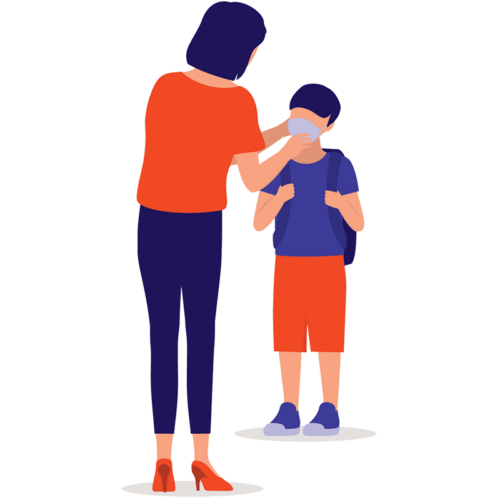How to Give Effective Instructions
A common complaint from parents is that their child just does not listen or do what they ask. Following instructions given by an adult is a skill that is necessary for a successful childhood. Fortunately, there are some things you can do to help build this skill.
Goal

Method

Use a calm, clear voice.
Make sure your child can hear you easily. If you must raise your voice to be heard, you are too far away—somewhere between three and six feet away is ideal.

Make sure you have their attention.
Say their name and wait for a response. Their response could be to look at you, say “yes,” or any other way to let you know that they heard you. Praise them when they acknowledge you (for example, “Thank you for looking at me when I called you”).

Use one-step instructions.
“Please shut the door” has only one step: shutting the door. “Please shut the door and hang up your coat” has two steps. Continue teaching one step instructions until following them is routine. Then (and only then) begin to teach them how to follow instructions with more than one step.

Be clear and specific.
Say exactly what you want your child to do. “Pick up that toy” is clear and specific. “Clean up this room” is unclear and not specific.

Make sure your child can follow the instruction.
They must be physically capable and have enough time to do what they are being asked to do. If your instruction is complex, break it down into doable steps and present one instruction (step) at a time.

Use instructions, not suggestions or requests.
“Pick up that toy” is an instruction. “It would be nice if you picked that toy up” is a suggestion. “Would you pick up that toy?” is a request. There is nothing wrong with using suggestions or requests in ordinary conversation, but both are vague and imply that not picking up the toy is an acceptable option. When the requested action is expected without exception, always use a clear, direct instruction.

Use “do” instructions, not “don’t” instructions.
“Move away from your sister” is a DO instruction, whereas “stop hitting your sister” is a DON’T instruction. Most caregivers use more DON’T than DO instructions, which is not very effective for teaching children to follow instructions.
Rely on DO instructions. Here’s why:
It is easier to start than stop
It is easier for children to stop what they are doing when you tell them to do something else than it is when you just tell them to stop.
There is something clear to praise
It is very hard to praise NOT doing something. But when a child follows a DO instruction, there is something clear and tangible to praise.
Praise even hints of compliance.
Use praise and encouragement often to help guide them as they learn new skills. Praise and encourage them when they start to follow an instruction, especially if it was difficult, and always praise them after they have followed the instruction correctly. Use specific praise that labels what they did. For example, “Thank you for putting your bear in the toy box.”
Give effective instructions and praise listening
In this video, Cadence’s dad tells her to put on her shoes. Notice how he uses a calm and clear voice, gets her attention before he gives the instruction, uses a one-step DO instruction, and phrases it as a statement rather than a suggestion.

Frequently mix physical affection in with your use of praise.
Physical affection such as hugs, pats on the head, and shoulder rubs are quick and effective ways to let your child know they have done a good job. Try to incorporate them whenever you can.
Challenges
Your child may not always listen, even when you follow all the tips in this tutorial. One of the best things you can do is stay calm and follow through on your instruction, like Sutton’s dad does in this video.
My child will not listen.
Your child will not do what you ask every single time. Incorporating praise (Step 8) is crucial to success. If the task is essential, follow through. Be consistent. Over time, you should see that your child is doing what you ask more often than not.
My child thinks it is funny when they don't listen.
Be careful not to unintentionally give your child attention for not obeying or for behaving unacceptably. Stay neutral and calm, and continue to follow through. They will be less likely to think it is funny if their behavior does not affect you.
Practice

Prepare
Pick some one-step tasks to use the strategies on.

Apply
Give an effective instruction that is clear and specific, and follow the guidelines in this tutorial.

Repeat
Practice at least once a day.
Next Steps
Add more practice opportunities.
After you have practiced for about a week and are getting comfortable with the strategies, use these tips when giving an instruction as frequently as possible. This will start to become more natural and effortless. After 2-3 weeks of practice, you should find that all instructions you give follow these guidelines.
Try multiple-step instructions.
You can also start to add in instructions with multiple steps. Start small with two-step instructions (e.g., “go to your room and get your socks”) before progressing to larger sequences. You really shouldn’t go beyond 3-4 steps.
